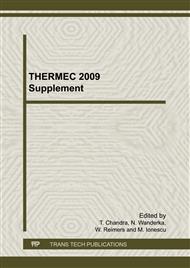p.443
p.449
p.455
p.461
p.467
p.473
p.479
p.485
p.491
An Investigation into Cracking in Nickel-Base Superalloy Repair Welds
Abstract:
The nickel-base superalloy Rene 80 is considered very susceptible to liquation and strain-age cracking. Material in the solutionised condition is welded using the Cold Metal Transfer, or CMT process (with ductile filler alloy) and autogenously using a laser. Grain size is shown to have a significant effect on cracking. Using the CMT, welding power is shown to have high significance on the level of cracking, whereas welding speed has little effect. When welding using the laser, it is shown that the power and spot size are more crucial to the material cracking than the travel speed. It is indicated that the weld bead geometry has high significance over the occurrence of cracking, with a relationship between welding power, weld bead geometry, and stresses controlling the occurrence and magnitude of cracking. Further, some laser welds are analysed after post-weld heat treatment, and there is a significant increase in cracking after this. However, 34% of samples contained no cracking in both the as-welded and post-weld heat treated state.
Info:
Periodical:
Pages:
467-472
Citation:
Online since:
January 2010
Authors:
Price:
Сopyright:
© 2010 Trans Tech Publications Ltd. All Rights Reserved
Share:
Citation:


